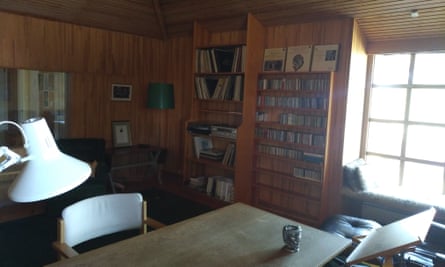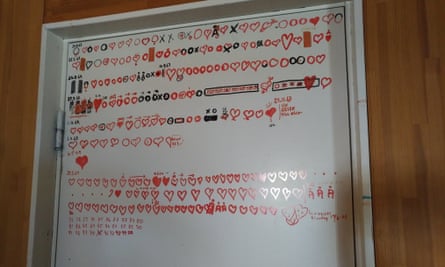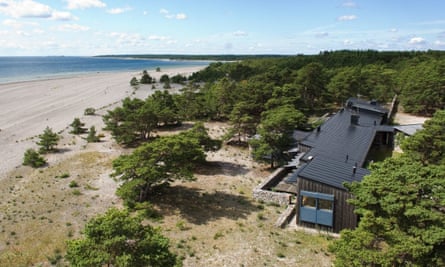An eerie kind of peace came over me as I sat in my battered Toyota rental car on the quayside at Fårösund. This is the gateway to the Gotland archipelago’s farthest flung outpost, the island of Fårö, better known as Bergman Island since the release of Mia Hansen-Løve’s 2021 film of that name. The Baltic lay as flat as the hundreds of placid lakes you fly over in the little island hopper from Stockholm Bromma airport. It was 10pm on 1 June, and the sky showed no sign of getting dark. The whole scene, including the rocky outcrops down in the bay, felt very … er … Bergmanesque.
I was coming to Fårö on a mission. In January, I had been invited to be writer-in-residence at the Fårö home of the Swedish director Ingmar Bergman. I had a screenplay to write, having just published my debut novel, Istria Gold. In the depths of a depressing winter, it was easy to say yes to something six months away and on an idyllic Baltic island. After 20 years carrying the Bergman baton as a board member of his brainchild, the European Film Academy (EFA) – including four as chair, and six as deputy to Agnieszka Holland – it was about time I got to know the man a little more. What better way of doing it than an extended stay at his home, on his estate. However, the reality of what the following month would hold began to dawn on me as I drove the last few desolate kilometres to the Bergman homestead. “Where have all the people gone?” I wondered.
Bergman moved into his house on Fårö in 1967, having first arrived on the island seven years earlier to scout locations for Through a Glass Darkly, and he lived here until his death almost exactly 16 years ago, in July 2007. The place now looks like a consummate exercise in Scandi chintz, a one-storey building designed to blend in beneath the pine trees, and offering a breathtaking view of the rocky shore and the Baltic Sea. The house was repeatedly extended throughout the years, and it was here that Bergman wrote and prepared his many film and theatre productions. In his autobiography, The Magic Lantern, he writes: “Fårö had been my security. I had lain as if in a womb without a thought that I should ever again have to leave.”
Every day for a month, at 9am sharp, I let myself into the maestro’s study, sat at his desk and waited for inspiration. I wasn’t trying to channel my inner Ingmar. I just wanted to work. Bergman’s chair faced away from the window. I moved it so I could look out as I wrote. Each to their own. From the corner window of Bergman’s den, the only distraction was the powerful call of the island’s barren landscape, one that has featured in at least seven of Bergman’s films, including Shame, Scenes from a Marriage and Persona. Inspiration comes not so much from the essence of the place, but the complete absence of anything else to do. There was nothing for it except to work.
There were times when I felt Bergman was looking over my shoulder and laughing gently to himself at my incompetence. I got my own back by photographing the childish scribbles and doodles he had the habit of doing on the furniture, floor, doors and bedside table. And the writing was on the wall – certainly in his office, where he used red and black marker pens to note the good days and the bad days. Red hearts for the good. Black crosses for the dark and depressed.

The end of my stay was marked by the start of the annual homage that is Bergman Week. As the torch bearer of the EFA, I had been asked to give the inaugural speech at the event, whose motto for 2023 was “sin and shame” – subjects, I felt confident, that I knew a thing or two about. It was to be given in the Fårö parish church where Bergman and his last wife, Ingrid, are buried. Aside from an afternoon fika (coffee and chitchat) with Jannike Åhlund, the Bergman Center Foundation chair, I hadn’t had an in-person conversation with anyone for a month. So, it was a surprise to meet so many local Fåröese at the church and to feel the tenderness they had for Bergman and to understand how protective they were of his legacy.
Standing at the altar, I could think of sin and shame only in terms of their ultimate bedfellow, redemption. Bergman knew this, and it was standing there that it dawned on me that the primary theme of Bergman’s work, the thread that links all his films across genres, is not the Bergman cliches of death and morbidity or sin or shame, but the redemptive possibility of love – and it was that which I found in the congregation of the Fårö church on that midsummer afternoon.

I had one last thing to do before leaving for the ferry. I had left my laptop in Bergman’s office; it contained the draft of my adaptation of Haki Stërmilli’s Albanian anti-patriarchy epistolatory novel, If I Were a Boy, from 1936, as well as the text of my novel Istria Black, a time-bending historical exploration of hate.
Entering the house, and walking down the long corridor, through the living room, I turned right and took a last look around the room in which so many masterpieces had been conceived, hoping against hope that some of the genius might have rubbed off. The office’s domed ceiling gave the strange effect of being in an oratory or some kind of chapel – and, for the very first time after a month working there, I had the feeling of it being a sacred space rather than my work space. I could almost hear plainsong. What’s more, I could have sworn I had left my laptop on the other side of the table. Maybe the cleaner had been in.

